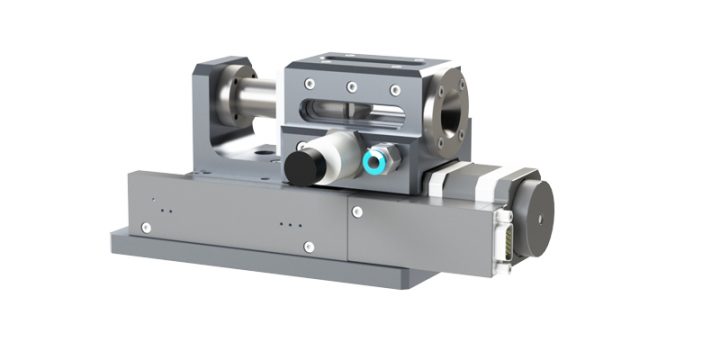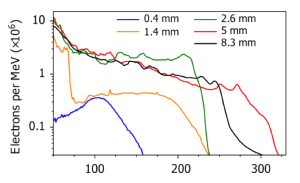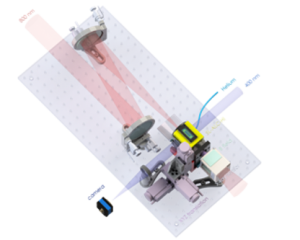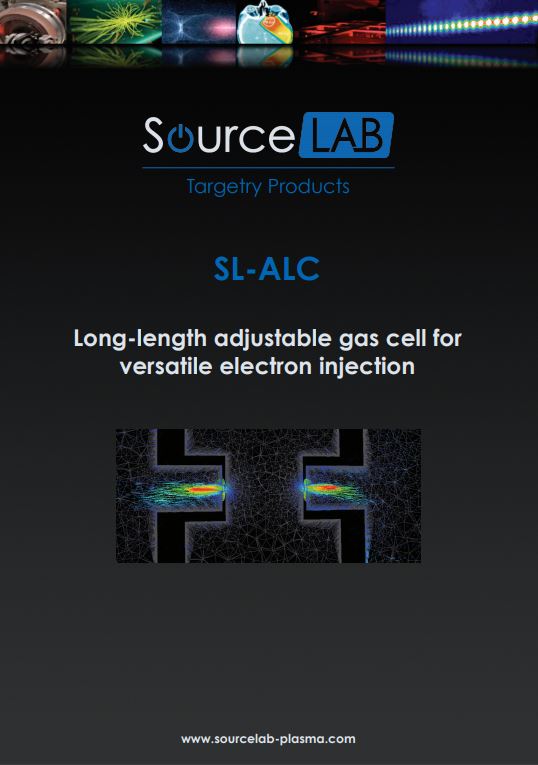TARGETRY
Your tool to control electron acceleration

The SL-ALC system
The SL-ALC-HI system is a motorized cell of adjustable length, conceived for laser-plasma interaction experiments at underdense regime, requiring mm-to-cm long stable medium in general (e– acceleration and diffraction, inverse Compton scattering, γ-ray generation, X-ray laser, high harmonic generation), and Laser Wakefield Acceleration (LWFA) at high repetition rate in particular.
High-precision monitoring
Fully motorized and easy to align
Optimal plasma imaging conditions
Pulsed and regulated pressure modes
High-precision monitoring
Fully motorized and easy to align
Optimal plasma imaging conditions
Pulsed and regulated pressure modes
Unique instrument to fine-study with optical diagnostics the physics of laser-plasma interaction in underdense regime
This system is designed to offer perfectly reproducible laser-plasma interaction conditions. The solid and shielding metallic housing and specific in-out nozzle design enable very reproducible shots with a multi-Terawatt to Petawatt laser system without fatal damaging and dangerous light backscattering at normal laser incidence. The gas-tightness is tested for resisting up to few bars of flow pressure (approx. 1020 atoms/cm3 at normal temperature).

Typical electron spectra for different SL-ALC length configuration with a 40 TW laser system

Possible implementation for electron acceleration and plasma observation
Detailed specifications:
Performances: stable gaseous medium up to 50 mm length
Stepper motor minimal increment / rectitude: 0.5 µm / 5 µm
Vacuum compatibility: 10-6torr
Inlet pressure: Up to 4 bar
Nozzles diameter: From 100 µm up to 2 mm
Pulsed flow mode: Optional
Dimensions / mass:196 x 99 x 80 mm / 1.5 kg
- F.Brandi et al.
Measurement of the particle number density in a pulsed flow gas cell with a second-harmonic interferometer
Journal of Physics: Conference Series, Volume 1079, conference 1 (2018)
- J. Shin et al.
Quasi-monoenergetic multi-GeV electron acceleration by optimizing the spatial and spectral phases of PW laser pulses
Plasma Physics and Controlled Fusion, Volume 60, Number 6 (2018)
- H.T. Kim et al.
Stable multi-GeV electron accelerator driven by waveform-controlled PW laser pulses
Scientific Reports volume 7, Article number: 10203 (2017)
- I.Prencipe et al
Targets for high repetition rate laser facilities: needs, challenges and perspectives
High Power Laser Science and Engineering, 5, e17 (2017)
- F. Brandi et al.
Note: Real-time monitoring via second-harmonic interferometry of a flow gas cell for laser wakefield acceleration
Review of Scientific Instruments 87, 086103 (2016)
- E. Guillaume et al.
Physics of fully-loaded laser-plasma accelerators
Phys. Rev. ST Accel. Beams, Volume 18, 061301, June (2015)
- Overview
-
Your tool to control electron acceleration

The SL-ALC system
The SL-ALC-HI system is a motorized cell of adjustable length, conceived for laser-plasma interaction experiments at underdense regime, requiring mm-to-cm long stable medium in general (e– acceleration and diffraction, inverse Compton scattering, γ-ray generation, X-ray laser, high harmonic generation), and Laser Wakefield Acceleration (LWFA) at high repetition rate in particular.
High-precision monitoring
Fully motorized and easy to align
Optimal plasma imaging conditions
Pulsed and regulated pressure modes
High-precision monitoring
Fully motorized and easy to align
Optimal plasma imaging conditions
Pulsed and regulated pressure modes
Unique instrument to fine-study with optical diagnostics the physics of laser-plasma interaction in underdense regime
This system is designed to offer perfectly reproducible laser-plasma interaction conditions. The solid and shielding metallic housing and specific in-out nozzle design enable very reproducible shots with a multi-Terawatt to Petawatt laser system without fatal damaging and dangerous light backscattering at normal laser incidence. The gas-tightness is tested for resisting up to few bars of flow pressure (approx. 1020 atoms/cm3 at normal temperature).

Typical electron spectra for different SL-ALC length configuration with a 40 TW laser system

Possible implementation for electron acceleration and plasma observation
- Specifications
-
Detailed specifications:
Performances: stable gaseous medium up to 50 mm length
Stepper motor minimal increment / rectitude: 0.5 µm / 5 µm
Vacuum compatibility: 10-6torr
Inlet pressure: Up to 4 barNozzles diameter: From 100 µm up to 2 mm
Pulsed flow mode: Optional
Dimensions / mass:196 x 99 x 80 mm / 1.5 kg - Downloads
- Publications
-
- F.Brandi et al.
Measurement of the particle number density in a pulsed flow gas cell with a second-harmonic interferometer
Journal of Physics: Conference Series, Volume 1079, conference 1 (2018)
- J. Shin et al.
Quasi-monoenergetic multi-GeV electron acceleration by optimizing the spatial and spectral phases of PW laser pulses
Plasma Physics and Controlled Fusion, Volume 60, Number 6 (2018)
- H.T. Kim et al.
Stable multi-GeV electron accelerator driven by waveform-controlled PW laser pulses
Scientific Reports volume 7, Article number: 10203 (2017)
- I.Prencipe et al
Targets for high repetition rate laser facilities: needs, challenges and perspectives
High Power Laser Science and Engineering, 5, e17 (2017)
- F. Brandi et al.
Note: Real-time monitoring via second-harmonic interferometry of a flow gas cell for laser wakefield acceleration
Review of Scientific Instruments 87, 086103 (2016)
- E. Guillaume et al.
Physics of fully-loaded laser-plasma accelerators
Phys. Rev. ST Accel. Beams, Volume 18, 061301, June (2015)
- F.Brandi et al.
